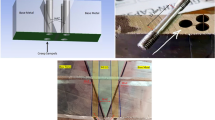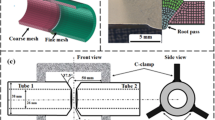Abstract
In this work, SUS 304 interlayers with different thicknesses were used to weld A6061 aluminum alloy and SUS 821L1 duplex stainless steel. The effects of interlayer thickness on welding results, air shock wave between plates, and weldability window were studied. The results indicated that the interlayer thickness had a significant effect on the welding results. The shear strength of the bonding was higher than 200 MPa, when the thickness of interlayer was 0.5 mm or 0.3 mm. With the decrease of interlayer thickness, the IMCs layer became thin. When the thickness of interlayer was 0.1 mm, the welding could not be achieved, due to the unmelted A6061. The air shock wave between the plates was studied. The pressure peak of the air shock wave was calculated using “Piston model”. The fluid–solid coupling finite element method was used to simulate the pressure in “Piston model” and the movement of the two different thickness interlayers (0.8 mm and 0.1 mm) under the action of the air shock wave. The simulation results indicated, with the increase of distance, the pressure peak of the air shock wave changed little, but the action time increased significantly, which improved the impulse of the air shock wave. It was proposed the influence of air shock wave should be reduced or eliminated when welding large area plates. The smoothed particle hydrodynamics (SPH) method was used to simulate the oblique impact process of the plates, and the unwelded samples were analyzed using the simulation results. In the analysis of weldability window, the influence of the interlayer on the upper and lower limits was examined, it was found that the interlayer led to an upward shift of the upper and lower limits, and the weldability window was expanded; the K value of the lower limit was obtained using numerical simulation. The collision angle between interlayer and base plate was estimated using numerical simulation.










Similar content being viewed by others
Data availability
Not applicable.
Code availability
Not applicable.
References
Hatano R, Ogura T, Matsuda T, Sano T, Hirose A (2018) Relationship between intermetallic compound layer thickness with deviation and interfacial strength for dissimilar joints of aluminum alloy and stainless steel. Mat Sci Eng A-Struct 735:361–366. https://doi.org/10.1016/j.msea.2018.08.065
Ogawa D, Kakiuchi T, Hashiba K, Uematsu Y (2019) Residual stress measurement of Al/steel dissimilar friction stir weld. Sci Technol Weld Join 24(8):685–694. https://doi.org/10.1080/13621718.2019.1588521
Nguyen VN, Nguyen QM, Huang SC (2018) Microstructure and mechanical properties of butt joints between stainless steel SUS304L and aluminum alloy A6061-T6 by TIG welding. Materials 11(7):1136. https://doi.org/10.3390/ma11071136
Liu S, Suzumura A, Ikeshoji TT, Yamazaki T (2005) Brazing of stainless steel to various aluminum alloys in air. JSME Int J A-Solid M 48(4):420–425. https://doi.org/10.1299/jsmea.48.420
Sherpa BB, Kumar PD, Upadhyay A, Kumar S, Agarwal A, Tyagi S (2021) Effect of explosive welding parameters on Al/LCS interface cladded by low velocity of detonation explosive welding (LVEW) process. Int J Adv Manuf Technol 113(11):3303–3317. https://doi.org/10.1007/s00170-021-06800-5
Malakhov A, Saikov I, Denisov I (2021) Brass/Invar bimetal by explosive welding. Int J Adv Manuf Technol 114(1):357–364. https://doi.org/10.1007/s00170-021-06897-8
Yang M, Ma H, Shen Z (2018) Study on self-restrained explosive welding with high energy efficiency. Int J Adv Manuf Technol 99(9):3123–3132. https://doi.org/10.1007/s00170-018-2600-y
Carvalho G, Galvão I, Mendes R, Leal R, Loureiro A (2018) Explosive welding of aluminium to stainless steel. J Mater Process Technol 262:340–349. https://doi.org/10.1016/j.jmatprotec.2018.06.042
Hokamoto K, Izuma T, Fujita M (1993) New explosive welding technique to weld. Metall Mater Trans A 24(10):2289–2297. https://doi.org/10.1007/BF02648602
Miao Y, Chen X, Wang H (2021) Some applications of interlayer explosive welding. Compos Interface:1–16. https://doi.org/10.1080/09276440.2021.1943142
Han JH, Ahn JP, Shin MC (2003) Effect of interlayer thickness on shear deformation behavior of AA5083 aluminum alloy/SS41 steel plates manufactured by explosive welding. J Mater Sci 2003 38(1):13–18. https://doi.org/10.1023/A:1021197328946
Carvalho G, Galvão I, Mendes R, Leal R, Loureiro A (2020) Explosive welding of aluminium to stainless steel using carbon steel and niobium interlayers. J Mater Process Technol 2020(283):116707. https://doi.org/10.1016/j.jmatprotec.2020.116707
Chen X, Inao D, Tanaka S, Mori A, Li X, Hokamoto K (2020) Explosive welding of Al alloys and high strength duplex stainless steel by controlling energetic conditions. J Manuf Process 58:1318–1333. https://doi.org/10.1016/j.jmapro.2020.09.03714
SUS304 Stainless steel material properties, chemical composition, meaning. (2021) The world material. https://www.theworldmaterial.com/sus304-stainless-steel-material/. Accessed 2 July 2021.
Duplex stainless steel. (2021) UEX,LTD. https://www.uexltd.co.jp/english/products/nisou_stainless/. Accessed 2 July 2021.
Aluminum vs. 5052 aluminum - differences in properties, strength and uses (2021) Thomas. https://www. thomasnet.com/articles/metals-metal-products/6061-aluminum-vs-5052-aluminum/. Accessed 2 July 2021.
Sakai Y (2012) Success with new products. https://www.metalbulletin.com/events/download.ashx/document/speaker/6540/a0ID000000X0jUf MAJ/Presentation. Accessed 20 April 2021.
Manikandan P, Hokamoto K, Deribas AA, Raghukandan K, Tomoshige R (2006) Explosive welding of titanium/stainless steel by controlling energetic conditions. Mater Trans 47(8):2049–2055. https://doi.org/10.2320/matertrans.47.2049
Crossland B (1982) Explosive welding of metals and its application. Clarendon Press • Oxford.
Deribas A (2001) Science of explosive welding: state of art. In Impact Engineering and Application, Proceeedings of the 4th International Symposium on Impact Engineering, Chiba, A.; Tanimura, S.; Hokamoto, K., Eds. ELSEVIER. 530-531.
Tanguay V, Higgins A (2004) The channel effect: coupling of the detonation and the precursor shock wave by precompression of the explosive. J Appl Phys 96(9):4894–4902. https://doi.org/10.1063/1.1787913
Taylor WC, Chown JB, Morita T (1968) Measurement of rf ionization rates in high- temperature air. J Appl Phys 39(1):191–194. https://doi.org/10.1063/1.1655730
Johnson G, Cook W (1969) Selected hugoniots: EOS. In 7th International Symposium on Ballistics. LA-4167-MS.
Yang X, Ling X, Zhou J (2014) Optimization of the fatigue resistance of AISI304 stainless steel by ultrasonic impact treatment. Int J Fatigue 61:28–38. https://doi.org/10.1016/j.ijfatigue.2013.12.003
Akram S, Jaffery SHI, Khan M, Fahad M, Mubashar A, Ali L (2018) Numerical and experimental investigation of Johnson–Cook material models for aluminum (Al 6061-T6) alloy using orthogonal machining approach. Adv Mech Eng 10(9):1687814018797794. https://doi.org/10.1177/1687814018797794
Mahmood Y, Guo B, Chen P, Zhou Q, Bhatti A (2020) Numerical study of an interlayer effect on explosively welded joints. Int J Multiphysics 14(1):69–80. https://doi.org/10.21152/1750-9548.14.1.69
Aizawa Y, Nishiwaki J, Harada Y, Muraishi S, Kumai S (2016) Experimental and numerical analysis of the formation behavior of intermediate layers at explosive welded Al/Fe joint interfaces. J Manuf Process 24:100–106. https://doi.org/10.1016/j.jmapro.2016.08.002
Zeng X, Li X, Li X, Mo F, Yan H (2019) Numerical study on the effect of thermal conduction on explosive welding interface. Int J Adv Manuf Technol 104(5):2607–2617. https://doi.org/10.1007/s00170-019-04054-w
Chen X, Li X, Wang X, Yan H, Li K, Zeng X (2019) Bonding mechanism of explosive compaction–welding sintering. J Manuf Process 46:1–15. https://doi.org/10.1016/j.jmapro.2019.08.018
Okada N, Tadokoro Y, Tsuge S, Gonome F, Kizaki M (2017) Lean duplex stainless steel for resources saving society. Zairyo-to-Kankyo 66(8):263–267. https://doi.org/10.3323/jcorr.66.263
Cowan G, Bergmann O, Holtzman A (1971) Mechanism of bond zone wave formation in explosion-clad metals. Metall Mater Trans B Process Metall Mater Process Sci 2(11):3145–3155. https://doi.org/10.1007/BF02814967
] De Rosset (2006) Analysis of explosive bonding parameters. Mater Manuf Process 21 (6): 634-638. https://doi.org/10.1080/10426910600611136
Acknowledgements
We sincerely thank Mr. M. Takashima and Mr. T. Akaike, Master’s degree candidates, Graduate School of Science and Technology, Kumamoto University, for their help and support in conducting the experiments.
Funding
This study was funded by the Institute of Industrial Nanomaterials, Kumamoto University (no grant numbers).
Author information
Authors and Affiliations
Contributions
Xiang Chen did the experiments and simulations, and wrote the paper. Xiaojie Li helped to do the theoretical analysis. Daisuke Inao and Shigeru Tanaka helped to do the experiments. Kazuyuki Hokamoto provided the funding and revised the paper.
Corresponding author
Ethics declarations
Ethics approval
Not applicable.
Consent to participate
All authors have approved to participate.
Consent for publication
The manuscript is approved by all authors for publication.
Conflict of interest
The authors declare no competing interests.
Additional information
Publisher’s note
Springer Nature remains neutral with regard to jurisdictional claims in published maps and institutional affiliations.
Rights and permissions
About this article
Cite this article
Chen, X., Li, X., Inao, D. et al. Study of explosive welding of A6061/SUS821L1 using interlayers with different thicknesses and the air shockwave between plates. Int J Adv Manuf Technol 116, 3779–3794 (2021). https://doi.org/10.1007/s00170-021-07755-3
Received:
Accepted:
Published:
Issue Date:
DOI: https://doi.org/10.1007/s00170-021-07755-3




